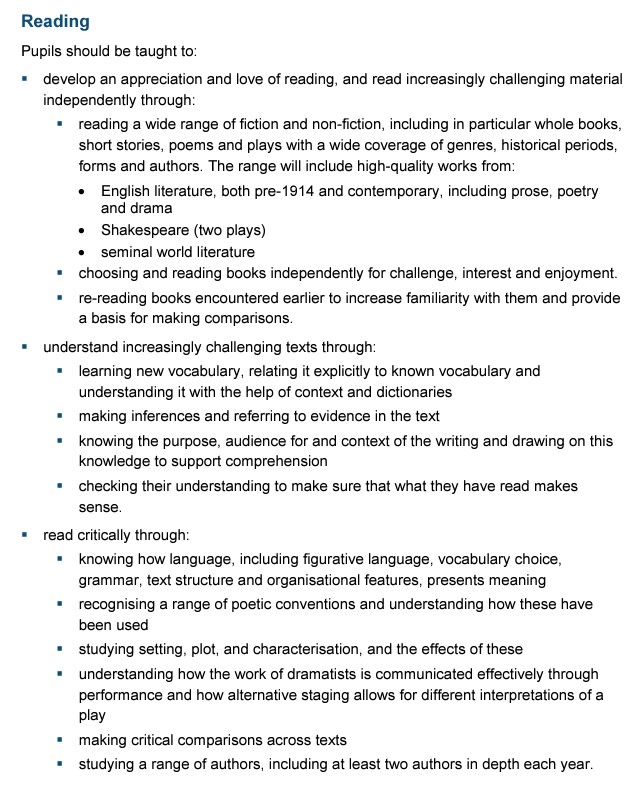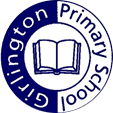Comprehension and Reading for Pleasure at Girlington
‘It is crucial for children to develop a life-long love of reading. Reading consists of two dimensions: language comprehension and word reading. Language comprehension (necessary for both reading and writing) starts from birth. It only develops when adults talk with children about the world around them and the books (stories and non-fiction) they read with them, and enjoy rhymes, poems and songs together. Skilled word reading, taught later, involves both the speedy working out of the pronunciation of unfamiliar printed words (decoding) and the speedy recognition of familiar printed words. Writing involves transcription (spelling and handwriting) and composition (articulating ideas and structuring them in speech, before writing). Statutory framework for the early years foundation stage 2021
‘Teachers should develop pupils’ reading and writing in all subjects to support their acquisition of knowledge. Pupils should be taught to read fluently, understand extended prose (both fiction and non-fiction) and be encouraged to read for pleasure. Schools should do everything to promote wider reading. They should provide library facilities and set ambitious expectations for reading at home.’ National Curriculum 2014
Aims
At Girlington Primary School our aim is to develop accomplished readers who will leave our school with a broad range of reading skills and a love of reading, in order to access and succeed in the secondary curriculum.
Guidelines
In school, reading is taught through whole class reading lessons and small group reading sessions reading sessions. The focus of whole class reading sessions is based on teaching a combination of word reading and comprehensions skills. These skills are taught through a variety of high-quality texts that have been carefully selected as part of a whole school reading spine.
Specific comprehension skills are taught within each year group using age appropriate objectives and activities. Objectives are taken from the National Curriculum and the Comprehension Progression at Girlington document.
We make summative judgements about the child as a reader, using a range of assessment information.
Teachers will use a range of evidence for assessment including:
- PIRA reading assessments
- PM Benchmark Reading Assessments
- Little Wandle assessments
- Teacher judgement from whole class and small group reading lessons
Ensuring reading for pleasure
‘Reading for pleasure is the single most important indicator of a child’s success.’ (OECD 2002)
‘The will influences the skill and vice versa.’ (OECD 2010)



We value reading for pleasure highly and work hard as a school to grow our Reading for Pleasure pedagogy.
- We read to children every day. We choose the books for our reading spine carefully as we want children to experience a wide range of books, including books that reflect the children at Girlington and our local community as well as books that open windows into other worlds and cultures.
- In Nursery/Reception, children have access to the reading corner every day in their free flow time and the books are continually refreshed.
- Children in Reception and KS1 have a home reading record. In KS2 children record what they are currently reading on a home learning sheet. The parent/carer records comments to share with the adults in school and the adults will write in this on a regular basis to ensure communication between home and school.
To see the progression of comprehension skills from EYFS to KS2 please see Comprehension Progression at Girlington.
Gems
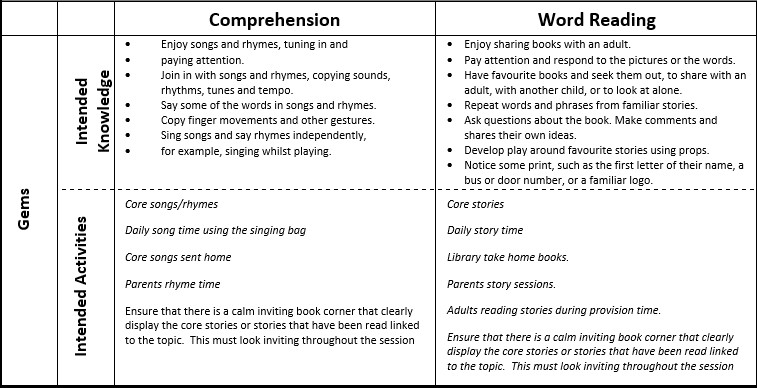
Nursery
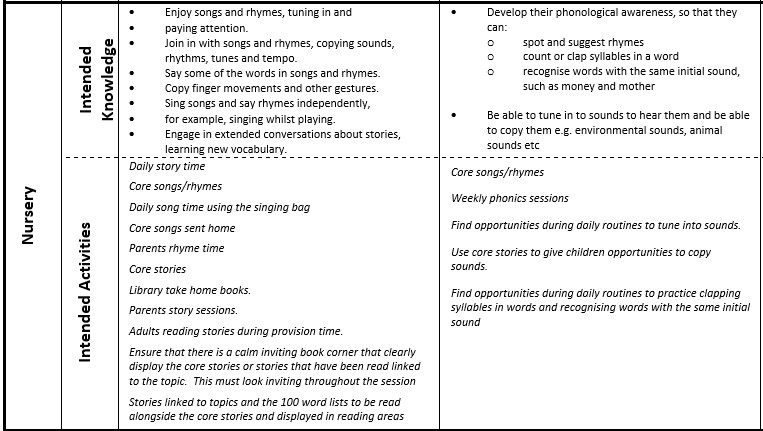
Reception
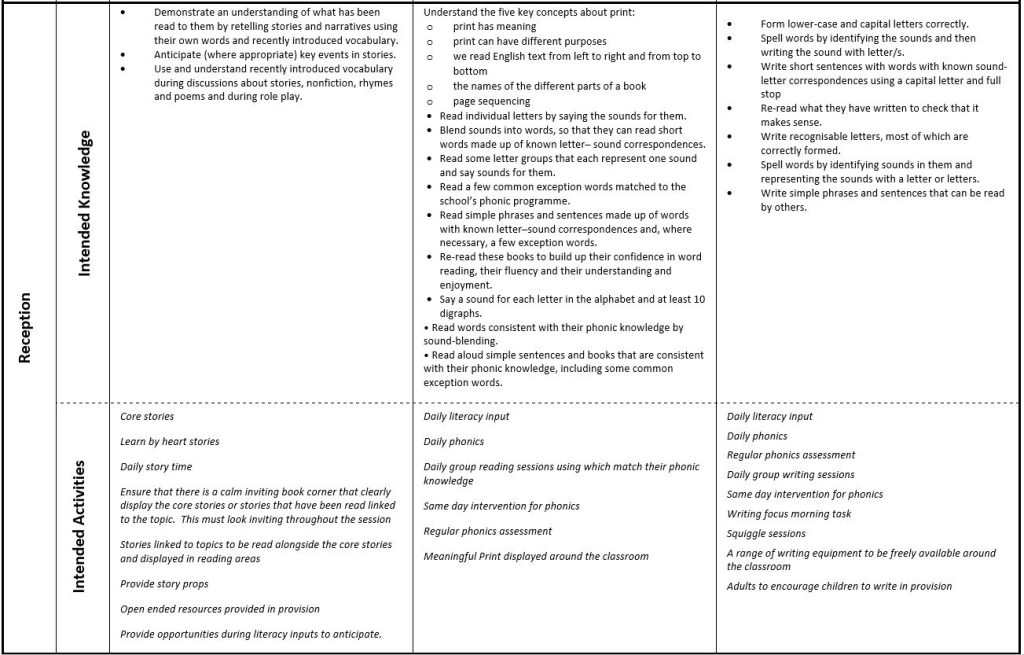
Year 1
National Curriculum for English, Year 1
Pupils should be taught how to read words with suffixes by being helped to build on the root words that they can read already. Pupils’ reading and re-reading of books that are closely matched to their developing phonic knowledge and knowledge of common exception words supports their fluency, as well as increasing their confidence in their reading skills. Fluent word reading greatly assists comprehension, especially when pupils come to read longer books
National Curriculum Programme of Study
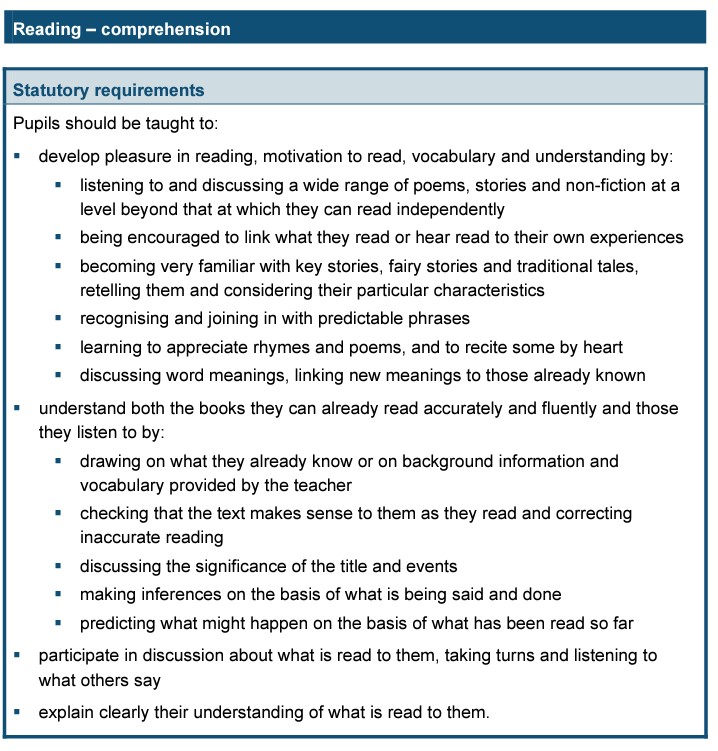
Year 2
National Curriculum for English, Year 2
By the beginning of year 2, pupils should be able to read all common graphemes. They should be able to read unfamiliar words containing these graphemes, accurately and without undue hesitation, by sounding them out in books that are matched closely to each pupil’s level of word reading knowledge. They should also be able to read many common words containing GPCs taught so far [for example, shout, hand, stop, or dream], without needing to blend the sounds out loud first. Pupils’ reading of common exception words [for example, you, could, many, or people], should be secure. Pupils will increase their fluency by being able to read these words easily and automatically. Finally, pupils should be able to retell some familiar stories that have been read to and discussed with them or that they have acted out during year 1.
During year 2, teachers should continue to focus on establishing pupils’ accurate and speedy word reading skills. They should also make sure that pupils listen to and discuss a wide range of stories, poems, plays and information books; this should include whole books. The sooner that pupils can read well and do so frequently, the sooner they will be able to increase their vocabulary, comprehension and their knowledge across the wider curriculum.
National Curriculum Programme of Study
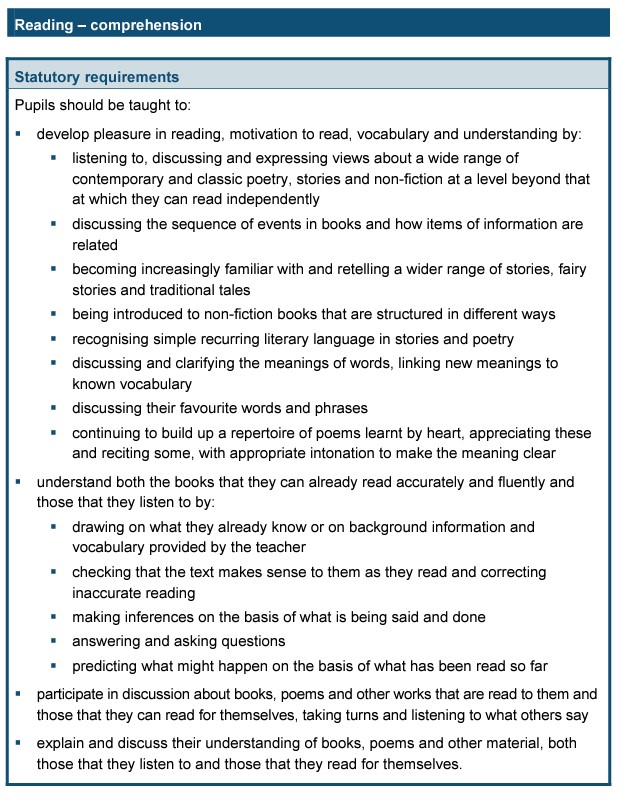
Year 3 and 4
National Curriculum for English, Years 3 and 4
By the beginning of year 3, pupils should be able to read books written at an age appropriate interest level. They should be able to read them accurately and at a speed that is sufficient for them to focus on understanding what they read rather than on decoding individual words. They should be able to decode most new words outside their spoken vocabulary, making a good approximation to the word’s pronunciation. As their decoding skills become increasingly secure, teaching should be directed more towards developing their vocabulary and the breadth and depth of their reading, making sure that they become independent, fluent and enthusiastic readers who read widely and frequently. They should be developing their understanding and enjoyment of stories, poetry, plays and non-fiction, and learning to read silently. They should also be developing their knowledge and skills in reading non-fiction about a wide range of subjects. They should be learning to justify their views about what they have read: with support at the start of year 3 and increasingly independently by the end of year 4
National Curriculum Programme of Study
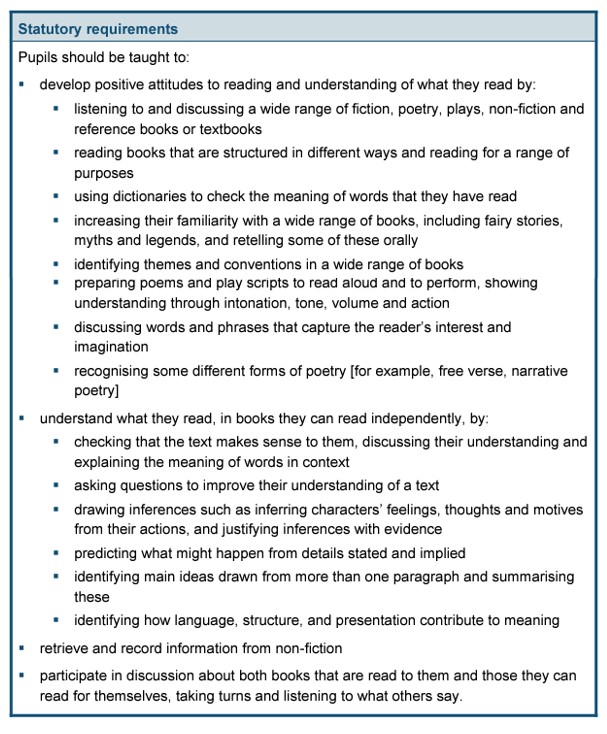
Year 5 and 6
National Curriculum for English, Years 5 and 6
By the beginning of year 5, pupils should be able to read aloud a wider range of poetry and books written at an age-appropriate interest level with accuracy and at a reasonable speaking pace. They should be able to read most words effortlessly and to work out how to pronounce unfamiliar written words with increasing automaticity. If the pronunciation sounds unfamiliar, they should ask for help in determining both the meaning of the word and how to pronounce it correctly.
They should be able to prepare readings, with appropriate intonation to show their understanding, and should be able to summarise and present a familiar story in their own words. They should be reading widely and frequently, outside as well as in school, for pleasure and information. They should be able to read silently, with good understanding, inferring the meanings of unfamiliar words, and then discuss what they have read.
National Curriculum Programme of Study
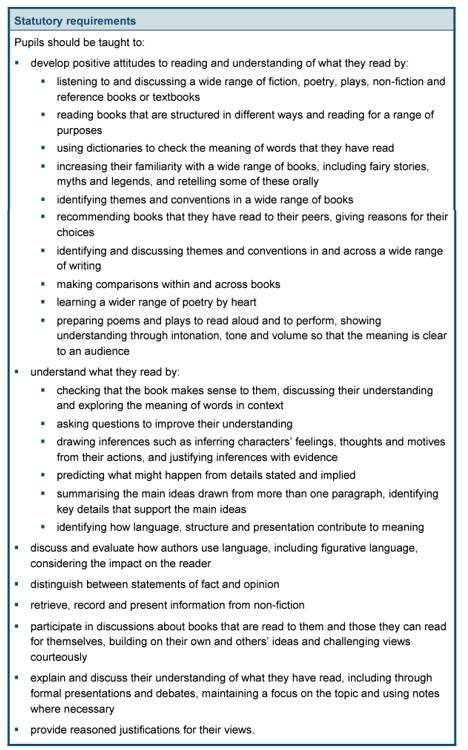
Reading at key stage 3 should be wide, varied and challenging. Pupils should be expected to read whole books, to read in depth and to read for pleasure and information.
Children should be taught to: develop an appreciation and love of reading, and read increasingly challenging material independently, understand increasingly challenging texts and to read critically. (See Appendix 1)

